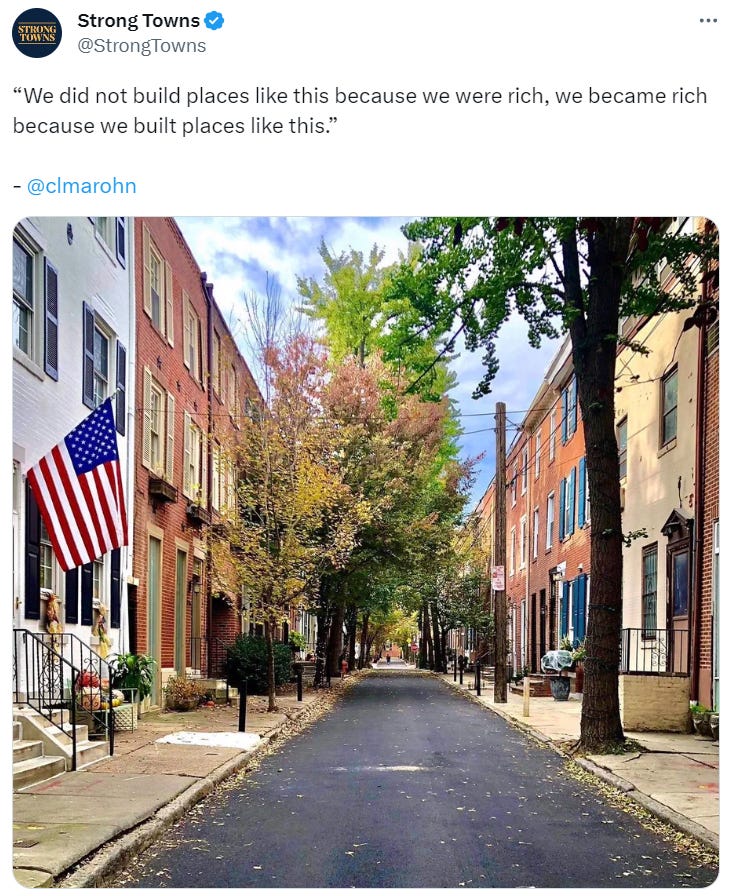I saw this tweet recently from Strong Towns:
This is a catchy way of condensing the central claim of Strong Towns: that classic urbanism is not just pretty, or conducive to building community, but that it’s financially productive. That is, this pattern is cheap and produces value, while suburbia is expensive and produces far less.
Some argue that this is wrong; as far as I can tell, based on comparisons of tax revenue, it is not wrong. But either way, what do these old places actually tell us? Obviously, we did build them when were much poorer. Are these things related?
Somewhere, I think in an interview, I mused that maybe classic urbanism was just what we built when we were poor. Maybe it really is true that as people get richer, they naturally want more space, more privacy, more quiet. That suburbia and the car are privileged in policy, yes, but ultimately represent something like the real preferences of a developed country.
What this would mean is that economic success contains its own destruction: we get rich, buy ourselves what we can’t afford, and go bankrupt because of it. (This makes me think, not incidentally, of $1,000 car payments on souped-up pickup trucks.)
What this suggests, then, is that in order to hold on to fiscal sustainability, we need to build below our means. To settle for less than we can, right now, afford. And I wonder if that is possible? And if that is not possible, then maybe urbanism—the actual small-scale, slightly chaotic, slightly cramped manner of living and doing business that these old built environments were connected with—is not possible today.
I say often that urbanism is much more than land use. It’s also this way of life and approach to commerce. The built environments that we think of as “urbanism” were in some ways the result of that way of life: symbiotic with it. I think American culture has evolved to be skeptical of this kind of living. But if Strong Towns is right, it’s our only option. Suburbia never penciled out. It was no different from a government entitlement, borrowing from the future to live large in the present.
I don’t really know how true this all is. But the idea of “building below your means” is an intriguing one. We don’t really live this way anymore, and neither do our governments. Some of this is economics and incentives, and some of it is culture. It’s interesting stuff. It might be deep.
Tell me what you think!
Related Reading:
Which Housing Is “Housing Crisis Housing”?
Thank you for reading! Please consider upgrading to a paid subscription to help support this newsletter. You’ll get a weekly subscribers-only post, plus full access to the archive: over 700 posts and growing. And you’ll help ensure more material like this!





I think the picture in that photo from Strong Towns is Philly and Philly is one of the most affordable , truly walkable urban places in the country. So I don't actually think that urbanism needs to be expensive. In fact, most of the expensive stuff in the city is new construction, which is pretty suburbanish (i.e. has a garage and a bloated amount of space). There are still a lot of inexpensive urban, walkable places from Baltimore north up to New Haven, it's just less desirable because of "quality of life" factors that draw people with money to other locations. I have a lot more to say, but my general point would be that cities aren't de facto expensive places.
Part of this is we just have to give cities a template for what better municipal code looks like, we really do lack clear templates for traditional development, such as row homes with an option for first floor retail
We have lost institutional knowledge and have to make it as easy as possible for local officials to adopt new best practices for walkability